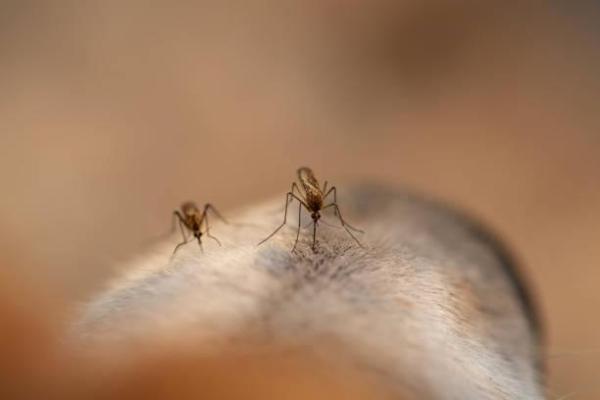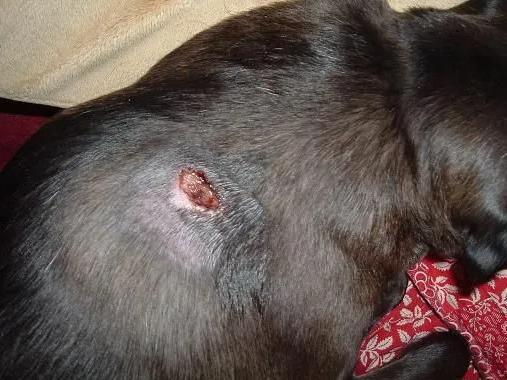Types of Bites in Dogs



See files for Dogs
Dog bites are a common concern for pet owners and anyone interacting with canines. While most dog bites are minor, it's important to be able to recognize different types of injuries and know when to seek professional help. This article will guide you through the various ways a dog bite can manifest, from small puncture wounds to more serious injuries. We'll discuss the signs and symptoms that indicate a potential infection or deeper tissue damage. By understanding the different types of dog bites, you can learn to assess the severity of the injury and take appropriate action.
This AnimalWised article explores the various types of bites dogs can experience, along with the most frequent signs and the recommended course of action.
Mite bites
Mites are minute organisms commonly found in dust or as parasites, affecting the skin and hair of our dogs. Mites target the dog's skin, feeding on its blood and causing various types of bites depending on the specific mite involved. Let us take a closer look at the most common mites and how we can identify them:
- Demodex canis inhabits the hair follicles of dogs and typically does not cause harm unless the dog's immune system weakens or during times of stress. This mite can lead to demodectic mange, resulting in alopecia and redness due to its bites. It generally does not provoke intense itching unless secondary infections occur.
- Sarcoptes scabiei causes sarcoptic mange, characterized by severe itching as it burrows into the dog's skin, worsening lesions and symptoms. This mite is highly contagious and can spread to other animals and even humans.
- Cheyletiella yasguri causes "walking dandruff," where skin peeling leads to redness and itching. This mite is contagious through direct contact or contaminated surfaces.
- Otodectes cynotis specifically targets the ears of dogs, causing a common form of mange also seen in cats. It triggers inflammation or otitis externa, characterized by itching, dark discharge, and scratching, which can lead to erosions and wounds.
What to do?
In all cases of mite infestation in dogs, it is crucial to seek veterinary care promptly. Treatment typically involves acaricides administered topically, orally, or by injection, along with medications for pain relief, inflammation, and sometimes specific shampoos to alleviate symptoms. Consulting with a veterinarian ensures the correct diagnosis and appropriate treatment plan tailored to the specific type of mite and severity of the infestation, promoting effective management and recovery for the affected dog.

Bee or wasp stings
Dogs, with their inquisitive noses and love for exploration, are particularly susceptible to bee and wasp stings. Their playful behavior often leads them to sniff or bat at these insects, triggering a painful sting. Common areas affected include the face, particularly the mouth, lips, and paws, as these are the areas most likely to come into contact with the insect during play.
Some dogs may experience a serious allergic reaction to bee or wasp stings, potentially leading to anaphylactic shock. However, most reactions are mild, typically causing pain, swelling, itching, and inflammation at the sting site within 20 minutes of the incident.
What to do?
If a dog is stung, the first step is to remove the stinger, which continues to release venom into the skin. Then, it is important to clean the area with water and mild soap or saline helps prevent infection.
Applying a cold compress wrapped in cloth can reduce swelling, but keep in mind that direct contact with frozen items should be avoided to prevent skin damage.
Monitoring the dog for signs of severe allergic reactions, such as difficulty breathing or swelling of the face, and seeking veterinary care promptly if these symptoms occur, is crucial for ensuring the dog's well-being.
Learn more about how to handle a bee sting on your dog with our next article's first-aid tips.

Spider bites
There are numerous species of spiders, and while most are harmless to dogs, some can pose serious health risks.
Among the most dangerous are the black widow (Latrodectus spp.), whose venom is highly toxic to the nervous system; the fiddleback spider, also known as the brown recluse (Loxosceles reclusa), which can cause severe tissue necrosis; and the Australian redback spider (Latrodectus hasseltii).
Most spider bites on dogs result in symptoms such as numbness, mild redness, swelling, itching, and scratching. These symptoms can predispose the area to infection, potentially leading to abscess formation and worsening of the condition.
Specifically, bites from fiddleback spiders typically cause immediate hardness and swelling in the affected area within the first six hours. Over the next 24 hours, the area may develop a distinctive appearance with pale, purple areas that darken and eventually form a hard, dark scab, which can progress into an ulcer.
What to do?
Treatment for spider bites in dogs varies depending on the type of spider and severity of the reaction. It is crucial to seek veterinary care promptly after a suspected spider bite to determine the appropriate treatment, which may include specific antidotes or medications to alleviate symptoms and prevent complications.
Learn more about how to keep your pup safe from spider bites in our next article.

Mosquito bites
Among the most common insect bites in dogs are those from mosquitoes. Mosquitoes are abundant in areas with streams, ponds, puddles, or stagnant water during the warmest months of the year, especially at dawn and dusk. Preventing our dogs from walking through these areas at those times is key to preventing mosquito bites.
Generally, when mosquitoes bite a dog, they produce small reddish bites that cause itching and inflammation, with bites on the face, nose, or inside the mouth being particularly annoying.
Some dogs may be especially sensitive to mosquito bites and may suffer an allergic reaction, potentially leading to anaphylactic shock—a veterinary emergency that can manifest a few hours after the bite. Symptoms of anaphylactic shock include breathing problems, increased nervousness, weakness, diarrhea, or vomiting.
Additionally, mosquitoes can spread diseases to dogs. For example, the sandfly (Phlebotomus spp.) carries Leishmania infantum, which causes canine leishmaniasis. Mosquitoes of various types can also transmit Dirofilaria immitis, the parasite that causes canine heartworm disease.
What to do?
If the dog shows any symptoms of anaphylactic shock, it is crucial to seek veterinary care immediately. If no alarming signs are present, no immediate action is required unless the dog has not been vaccinated against leishmaniasis, placing it at risk of developing the disease. In such cases, it is advisable to test for infection to determine if the dog has been exposed to the pathogen.
Explore natural methods for preventing mosquito-borne diseases in dogs in our next article.

Flea bites
When discussing types of bites in dogs, we must not forget about fleas, the most common parasites in these animals. Specifically, the cat flea (Ctenocephalides felis) is the most prevalent in both cats and dogs. Its life cycle lasts from several weeks to a month or more, depending on environmental conditions, with spring and autumn being ideal times for their development.
Flea bites cause itching, and some sensitive dogs may develop an allergy known as flea bite dermatitis. This hypersensitivity occurs when the dog's immune system overreacts to proteins in flea saliva, leading to an inflammatory skin reaction. Symptoms include agitation, itching, hair loss, skin excoriations, alopecia, and lesions with suppuration.
Fleas can also transmit infectious agents like Dipylidium caninum, also known as tapeworm, Rickettsia - which causes spotted fever or typhus, Mycoplasma, which can cause respiratory infections in dogs, and filariae, also known as heartworm.
What to do?
To eliminate fleas in dogs, administering an antiparasitic treatment is necessary. These treatments can come in the form of pipettes, syrups, or tablets. After eliminating the fleas, it is important to establish a regular deworming schedule to prevent future infestations.
Discover effective methods to remove fleas and restore your dog's comfort in our next article.

Tick bites
Ticks are parasites that can also bite dogs, especially in the countryside or in areas with a lot of vegetation and grass. One of the ticks that most frequently parasitizes our dogs is Rhipicephalus sanguineus, which generally bites on the belly, armpits, groin, lips, around the eyes, or between the toes. Notably, the tick bite is painless because its saliva contains anesthetic substances, and it typically causes slight inflammation.
Ticks can remain attached at the site of the bite, feeding on the dog, until they are either removed incorrectly or the dog scratches or bites at them. If not removed properly, the tick’s head can remain embedded, potentially causing an infection and forming an ulcer or infected wound.
These parasites can also transmit a range of infectious agents that cause serious diseases in dogs, including canine ehrlichiosis (fever, lethargy, bleeding problems), anaplasmosis (fever, weakness, loss of appetite), babesiosis (pale gums, weakness, dark urine), Lyme disease (joint pain, fever, lethargy), and hepatozoonosis (fever, weight loss, muscle weakness).
What to do?
To remove a tick correctly, it is necessary to use special tweezers and exercise great care. It is also advisable to administer an antiparasitic treatment to address any additional ticks and prevent future bites.
Learn how to identify different tick species and take preventive action in our next article.

This article is purely informative. AnimalWised does not have the authority to prescribe any veterinary treatment or create a diagnosis. We invite you to take your pet to the veterinarian if they are suffering from any condition or pain.
If you want to read similar articles to Types of Bites in Dogs, we recommend you visit our Prevention category.











